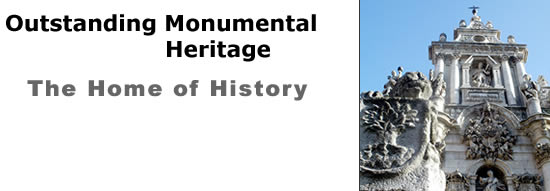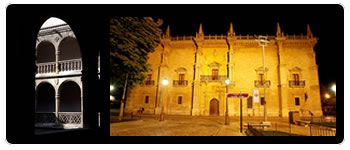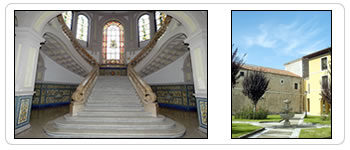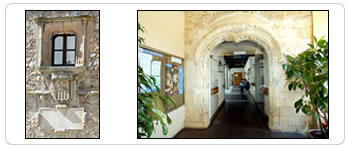 |
  


|
|
 
The patio has a layout of mathematical proportions. It has three levels, with seven arcades of stilted semi-circular arches on each side, set on octagonal pillars. On the right-hand side of the ground level is the Chapel, refurbished during the neoclassical period and covered with a quadripartite vault. The chapel is dedicated to El Cristo de la Luz, and houses a statue that is a masterpiece by Gregorio Fernández from his later period, between 1631 and 1636. On the other side of this gallery, a semi-circular porch leads us to the Aula Triste, a solemn hall of minor orders covered with lattice vaults and choir stalls with a platform and chair dating from the time of Queen Isabella II. The first level holds the outstanding History Library, containing a large hall housing spectacular woodwork shelving carved in 1705 by the joiner Alonso de Manzano, toghether with a large portrait of the Cardinal on horseback by the Valladolid painter Manuel Peti Vander. A two-floor brick building was built onto the northeast corner, on which the Baroque façade of the nearby 1740 College of San Ambrosio was placed. |
| 
Santa Cruz Palace
|
Near the Palace of Santa Cruz, seat of the chancellor's office, the university looks onto the city through an exceptional Baroque façade built between 1717 and 1718, following the desing of Pedro de la Visitación. It leads to the Historical Building, constructed on the site of the original medieval Studio, which was demolised and rebuilt several times until, at the beginning of the 20th century, the architect Teodosio Torres gave it its current form, conserving only the façade due to its exceptional architectural and symbolic value. Its central body is crowned by the emblem of the university, a sculpture of the Victory of Wisdom over ignorance and the representation of the monarchs who where most prominent in their protection of the University of Valladolid; Henry III, who donated his Tercias (ecclesiastic taxes) to the University; John I, who exempted its members from payment of taxes; and Philip II, who awarded the university full jurisdiction.
|

Historical Building
|
Other buildings complete the historical-architectural heritage of the university. Outstanding in the city of Valladolid is the House of Los Zúñiga, one of the first examples of Renaissance-style domestic architecture in Valladolid, home to the Buendía Centre and the Publications Department Secretary’s Office, and the so-called Casas de la Beneficencia (Houses of Social Welfare), two splendid examples of 16th century palatial architecture, today housing university administration offices. Equally treasured is the late 17th century Prison of the Royal Chancery, currently the Reina Sofía University Library, and the former Hostelry of Santa Cruz College (now a hall of residence), which dates from the last third of the 17th century.
On the Palencia campus, the University of Valladolid can boast modern infrastructure which includes the outstanding rationalist building of the former factory known as La Yutera, recently refurbished and now the Faculty of Work Sciences and the University School of Education. In Segovia, the University of Valladolid also has an exceptional heritage of buildings, in particular, Mansilla Palace, a magnificent example of Castilian palatial architecture, and the 18th century House of La Tierra, home to the meetings of the Comunidad de Ciudad y Tierra of Segovia. In Soria, stands the sumptuous 16th century Convent of La Merced, currently home to the University School of Business Studies, the Duques de Soria University Residence and Foundation and the former 19th century Santa Clara Hospital, which houses the Faculty of Translation and the University School of Physiotherapy.
|

University School
of Business (Soria) & Faculty of Social, Legal and Comm. Sciences
(Segovia) |

|
|










